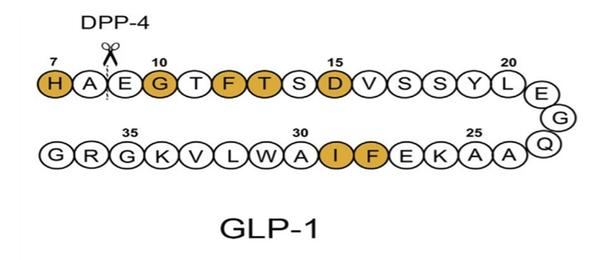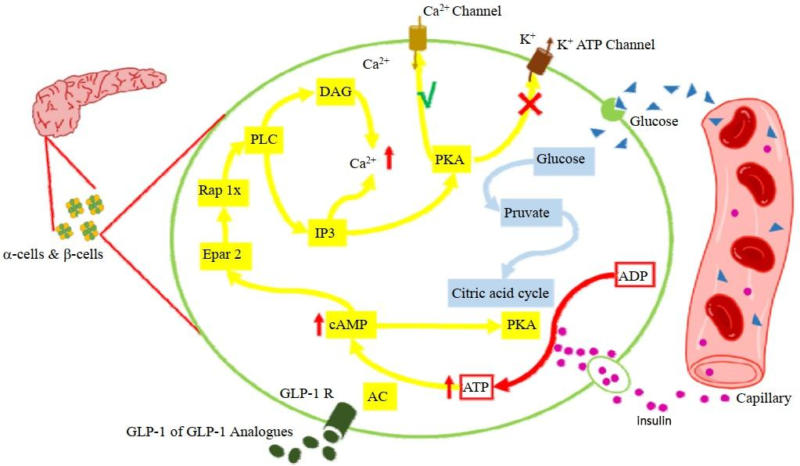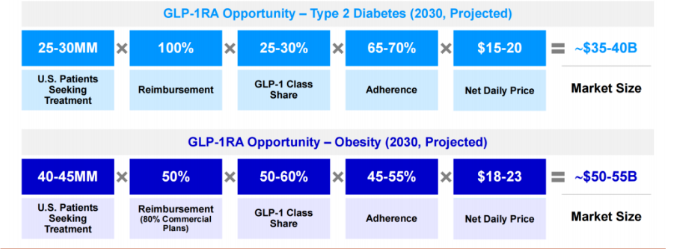Abstract: GLP-1 is the hormone secreted by intestinal L cell. Food intake can activate GLP-1 receptor to regulate blood sugar level. GLP-1 decreases blood sugar via reducing the secretion of glucagon and promoting islet β cell to secrete insulin. Besides, GLP-1 helps the proliferation and protection of islet β cell. However, GLP-1 is rapidly hydrolyzed by enzymes. The treatment of diabetes requires higher dosage of GLP-1, possibly inducing side effects(e.g. nausea) to make clinical applications more difficult.
Keywords: GLP-1 Drug, Blood Sugar Control, Diabetes, Obesity, Metabolic Diseases
1. GLP-1 Structure
GLP-1(Glucagon Like Peptide 1) is the peptide hormone consisting of 30 amino acids, and a member of glucagon family. The structure includes two parts: N-terminal binds with GLP-1 receptor and initiates physiological effect. C-terminal includes active peptide fragment, supporting the secretion of insulin and protection of β cell. GLP-1 is rapidly degraded by DPP-4 enzyme in the body, showing the shorter half life. This feature requires the continuous supplement of GLP-1 during the treatment of diabetes.

2. GLP-1 for the Treatment of T2DM
Usually, the daytime concentration of GLP-1 in human blood is higher than night. Intake of nutrients can stimulate the secretion of GLP-1 to promote the release of insulin. Especially, protein intake can promote the synthesis of GLP-1. However, the GLP-1 secretory function of T2DM patients decreases after eating nutrients. The effects of incretin declines. Intravenous injection of GLP-1 can improve GLP-1 level in the blood of T2DM patients and help blood sugar control. GLP-1 affects islet βcell via binding with GLP-1 receptor(GLP-1R), leading to depolarization of cell membrane and increased concentration of Ca2+. Thus, the insulin secretion is promoted. This process is glucose-dependent. Glucose can close ATP-dependent K+ channel and activate Ca2+ channel to promote insulin release.

3. GLP-1 Drug Market
Currently, various GLP-1 drugs are available in the market and widely applied in the treatment of T2DM and obesity. Semaglutide(Ozempic, Rybelsus, Wegovy) from Novo Nordisk and Tirzepatide(Mounjaro, Zepbound) from Eli Lilly are the most famous GLP-1 drugs. These drugs show obvious curative effect in diabetes treatment and weight loss area, and also bring great market size of billions of dollars.

4. Distribution and Innovation of Pharmaceutical Enterprise
Since the approval of Tirzepatide(GLP-1/GIP dual receptor agonist) in 2022, the dual target research on GLP-1 is very rapid. Currently, the drug development for GLP-1R/GIPR dual target attracts close attention. Especially clinical data of MariTide(AMG133, GLP-1 agonist/GIP antagonist, Amgen) in Phase 2 show average weight loss during 52 weeks is about 20%. Most dual target drugs are dual receptor agonists. MariTide may bring new breakthrough to obesity treatment.
In recent years, GLP-1 drug market rapidly increases. Till 2030, global market will overshoot hundreds of billions of dollars. Since the continuous incidence rise of metabolic diseases(e.g. obesity, diabetes), the market demand for efficient and convenient drugs also increases. Oral GLP-1 drugs have broad development space, attracting more and more pharmaceutical enterprises.
5. Recommended Products
| Recommended Antibodies | |
| Cat.No | Product Name |
| FNab02520 | DPP4 antibody |
| FNab10994 | GLP1R antibody |
| FNab09633 | ZGLP1 antibody |
| Recommended Proteins | |
| Cat.No | Product Name |
| P5193 | Recombinant Human GLP1R |
| P4142 | Recombinant Mouse GLP1R |
REFERENCES
[1]Osteoarthritis treatment via the GLP-1-mediated gut-joint axis targets intestinal FXR signaling, PMID: 40179178.
[2]Effect of pemvidutide, a GLP-1/glucagon dual receptor agonist, on MASLD: A randomized, double-blind, placebo-controlled study, PMID: 39002641.
